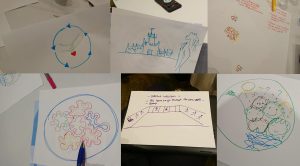Artlab
Name/School/ Email address
Tina O’Connell / Art / t.oconnell@reading.ac.uk
Overview
ArtLab is a dedicated art and technology facility that supports Outreach and Widening Participation, by bringing a wide range of children from across different social backgrounds into contact with cutting edge art and technology projects that are co-delivered with Undergraduate Art students (as student co-researchers). Underlying this idea are a set of core educational values concerning the deeper understanding of computing, digital media and new technologies that will form part of a vibrant cultural and economically viable society both today and in the future. The impact on our students derives from the experiences they gain in the delivery of numerous workshops with Primary and Secondary schools as well as a range of other public institutions over the last 4 years (see below). Further to this, the intention is to share knowledge and experience in order to provide a focus for other University of Reading department’s initiatives in this area.
Objectives
- To work with undergraduate co-researchers, who learn about a wide range of cutting-edge art and technology projects and co-deliver art-based pedagogic workshops to children from across different social backgrounds.
- To enable our student co-researchers to understand their potential role as educators, and the value that art brings when combined with developing skills in technology, including offering potential careers within the fastest growing sector in the UK, the creative economy.
- To encourage these co-researcher students to share their positive experiences with WP schools, helping a shift in mind set from STEM to STEAM (including Arts) and opening up this area to help pupils develop academic and practical skills that are not currently taught in mainstream schools.
- To introduce pupils from State schools to University contexts through direct experiences with our co-researchers who are frequently students of similar backgrounds.
Context
Within the current educational context (and despite the global acclaim and economic success of the UK Creative Economy) Art and associated disciplines are increasingly de-prioritised or excluded from school curricula; and Art and Science/technology are presented as separate (or mutually exclusive) spheres of study. As such Art and our art students whilst being some of the most sought-after graduates are increasingly positioned as studying a non-essential subject and Arts subjects are increasingly inaccessible to children from State schools.
Implementation
Artlab was set up in 2013 to address these issues and has subsequently organised over 100 workshops, school visits, open days and other events at Primary and Secondary schools and Public institutions such as the Tate and MERL with our student co-researchers.
For instance, in this last academic year (2017-18) Artlab delivered workshops to 29 primary schools involving co-researchers, around 870 children by working closely with 52 teachers and teaching assistants. If we include Reading Scholar, Stellar Projects MERL, Reading International, Tate Exchange and other WP workshops ArtLab co-researchers engaged with over 4,800 potential beneficiaries in the process. One part of a range of the planned activities being coordinated at this time is Tate Exchange, a dynamic public engagement programme that will be central to the public facing activity of Artlab and for educating our students to the nature and reach of social practice. Spearheaded by Artlab, this represents the opportunity for our co-researchers; Reading students, as well as the Stellar Project team (children from Maiden Erleigh School) and our Reading Scholar Students (external A level students) who work with us at Tate on new projects that engage with the idea of ‘production’ – in particular drawing on the ideas and approaches that we have successfully pursued to date – art and technology.
Impact
- ArtLab was nominated and shortlisted for Reading Cultural Award.
Artlab is a partner of Reading International, which has received financial support from Arts Council of England. - ArtLab has helped MERL and READING MUSEUM in its application to ACE to become an NPO, securing £8,000 per year for 3 years delivering Arts MARK for ArtLab.
- Providing teaching experience/mentoring for our Reading students – or co-researchers, as well as iReading Scholars, by inducting them into use of new technologies.
- Co-researchers are supported in how to conceive, deliver and part take in workshops, and this has an impact on their future carer choices and their skills base within the creative economy.
- The ArtLab Placement is a 20-credit module (as part of ArtMark NPO successful, bid see above) this year there are 3 students on the module delivered by ArtLab. In association with Christ the King Primary School (CKP) Maiden Erlegh East (MEE) Secondary School, MERL and Reading Museum.
- Summer Workshops over 24 days in June and July each year, ArtLab works with 10 local WP Primary Schools in Berkshire, UK. Including undergraduates, postgraduates, lecturers, teachers and school students working as co-researchers.
- ArtLab’s PhD Student Outreach the University funds a fees only PhD student
Reflections
There continues to be strong evidence in our evaluation to indicate that the activity has led to deeper forms of engagement by our students, as well as an increase in applications to the University. The evidence can be seen as effective in respect of students across a range of skills, and interests. The success has exceeded our aims in terms of its effects, with much of our success evident in shifts to the success of progression of our students and their impact on cultures and values being developed in primary schools, that that then help shift attitudes in Secondary School pupils. This was an effective approach as pupils resist pressure to drop Art. In this respect this shift in attitudes increases both our students and associated pupils confidence in undertaking degrees in which they can see clear career prospects relating to creative and analytical skills as outlined. For the University, this has explained in part the uptake of some pupils in studying for joint honours degrees, providing further evidence of their value to admissions.
Follow Up
We will continue our approach which has proven to be successful and attracted very considerable support and recognition including further funding from across the University and from independent organisations such as the Arts Council of England.
TEF
TQ1 LE1 SO1 LE2 S02 LE3 SO3 TQ5



